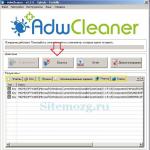In this article we will show how to connect a network directory located on Windows Server 2012 R2 as a separate storage (datastore) on a VMware ESXi host and use it to store virtual machine files and ISO images. VMWare ESXi cannot work directly with shared Windows folders(via the SMB protocol), so we will have to use another method.
ESXi allows you to use the following types of storage as a datastore:
- Local disk or LUN on external device storage connected via Fiber Channel or iSCSI
- Network File System (NFS) – this network protocol mainly used for remote access To file system in a Unix/Linux environment
Functionality in the server room Microsoft platform appeared in Windows Server 2003 R2, and is still supported in Windows Server 2012 R2.
Advice. Using an NFS directory as file storage for VMWare virtual machines is recommended only in test, lab, and non-critical production environments.
So, we first need to set up an NFS directory on Windows 2012 R2 and connect it as storage on the ESXi host. Let's assume we already have Windows server with the File Services role installed ( File and Storage Services). To install NFS server functionality:
Advice. You can install the Server for NFS feature with just one Powershell command:
Add-WindowsFeature "FS-NFS-Service"
Next you need to create a Windows directory that will be used as a point NFS mount. As an example, we created a directory c:\nfs(actually this is not the best place to create shared folder, preferably a separate drive or folder with a hard quota assignment).
In the console Server Manager go to section File and Storage Services-> Shares. Run the Create New Resource Wizard ( Tasks -> New Share) and select NFS Share-Quick.  Specify the path to the directory and its name. In our example it is called nfs. In this case, the full NSF path (path to the remote share) that will be used in a Unix environment to access this directory will be: msk-fs01:/nfs
Specify the path to the directory and its name. In our example it is called nfs. In this case, the full NSF path (path to the remote share) that will be used in a Unix environment to access this directory will be: msk-fs01:/nfs

On the Authentication Types tab, disable Kerberos authentication, and select “No Server authentication” and “Enable unmapped user access”.

Let's restrict access to the directory by the IP address of the ESXi host. To do this, we indicate the IP address of the server and grant it the rights Read/Write And Allow root access.

Advice. You can also restrict access to the NFS service using using Windows Firewall, restricting access from everywhere except certain IP addresses or subnets.
You can also create a shared NFS directory and restrict access to it using PowerShell:
New-NfsShare -Name "NFS " -Path "c:\nfs" -AllowRootAccess $true -Permission Readwrite -Authentication sys
Grant-NfsSharePermission -Name “NFS” -ClientName 192.168.1.11 -ClientType host -LanguageEncoding ANSI
So we've created a new NFS network share on Windows Server 2012 R2. All that remains is to connect it as storage on the VMWare ESXi host.
Advice. Before moving on to the next steps, make sure the vmkernel port is configured on your ESXi server.

After successfully adding NFS storage, it will appear in the list of available host storages. You can use this empty storage to store VM files or ISO images.

Recently, more and more paid programs can be found for free on torrent trackers in the virtual OS environment. With the power of computers, it is no longer a problem to run, for example, a virtual machine with Windows XP under Windows 7 and work in a second one without loss of performance. So I had to install vmware workstation on Windows 7.
In more detail, which paid programs are interesting to me can be used for free in virtual machine can be read on the blog pages seohod.ru
Today I want to write a little about something else. Virtual machines with installed paid programs and automatic tuning The Internet is good. But sometimes you need to quickly transfer necessary files there. Writing them to disk is time-consuming, tedious and irrational. Then there are two solutions to this problem.
You can connect shared folders or the ability to see a flash drive in the virtual machine.
Let's start with the last one.
To do this, you need to select the required virtual machine. Then on the tab you can go two ways. 
Next, in the device field, you can click on the line USB controller is present, or go to the top menu Virtual machine - Settings and select USB controller is present.
In any of these cases, we find ourselves in such a window. 
Now we at least know where the checkbox should be for USB 2.0 support
Then I did the following. Turned off vmware workstation.
In the folder C:\ProgramData\VMware\VMware Workstation, I opened the config.ini file and added the line to it:
Usb.EnablePnpMgr = TRUE
After that, I saved the file and turned on vmware workstation. Then I opened the USB controller tab and turned it on USB support 2.0. In fact, such manipulations are done only for a finished virtual machine, for which USB support was not connected when it was created.
Agree, all this is not very simple. But it is not logical to connect to ready-made virtual machines something that was not connected by default. After all, the structure may be disrupted and a valuable program that is tied to the hardware will stop working.
In this case, the only correct solution is to connect shared folders. In virtual vmware machine You can connect shared folders in Edit - Settings - Workstation. 
There, check the box next to “Enable all shared folders by default.” Now the virtual machine will see the shared folders and have access to them.
I will describe how to make such a shared folder and some nuances with password protection in the next publication.
To work with virtual machines In the desktop software market, there are, in fact, only two programs - this and . All the rest are either little-known, or with limited functionality, or are intended for system administrators and are overly complex for average users. The VirtualBox program beats its competitor in only one advantage - it is a free product. While VMware Workstation, being paid program, allows you to use virtualization capabilities operating systems to a greater extent. In particular, VMware Workstation saves system resources and allows you to work with the program’s functionality without unnecessary “dancing with a tambourine” - for example, using a common folder for the main (installed on a physical computer) and guest (virtual) operating systems.
A shared folder is a necessary functionality. Since the power capabilities of the virtual machine are much weaker physical computer, surfing the web in search of interesting software is much easier on the main operating system. While surfing the web, you can immediately download programs that interest you to this shared folder, and then select a separate time and launch a virtual machine to actually test these programs. Thus, without putting the main operating system at risk.
To set up a shared folder, in VMware Workstation you do not need to install any guest operating system add-ons, as you do in VirtualBox. You don't need to search forums for instructions on how to make the shared folder on a virtual machine visible in System Explorer. In VMware Workstation, using a shared folder is very easy. We will look at how to do this below.
So, how to set up a shared folder for the main and guest operating systems in VMware program Workstation?
To set up a shared folder that will provide access to files of both the main and guest operating systems, we will resort to the VMware Workstation settings. Open the program tab with information about the virtual machine and select the option to change its settings.

In the settings window, switch to the virtual machine settings tab and click on the “ Shared folders" You can read the program's information help, which warns about the possible dangers of using a shared folder. If you are not afraid of this, feel free to activate the option “ Always on" Also enable the option to connect the shared folder as network drive. So it will always be visible in the main sections of the virtual operating system explorer.

The Add Shared Folder Wizard window will open. Click " Next».

Use the " Review"to select a folder on the main operating system that will be common to both systems.

Select a folder from those available on your computer. Or create a new folder specifically for working with virtual machines.

In the Add Shared Folder Wizard window, click " Next».

In the next wizard window, you can limit the interaction between the main and guest systems by setting the option " Read-only" In this case, files from one operating system located in a shared folder cannot be modified by opening them on another system. In principle, this is not necessary, since you can simply not place files that are important to you in a shared folder if you are afraid that they may be damaged by a virus that has penetrated the virtual operating system. Click " Ready».

The virtual machine information window will appear again, where the selected shared folder will already be indicated. Click " OK».

That’s it – you can test the settings you have made. Launch the guest operating system, open Explorer and look for a shared folder among the mapped network drives.

Did this article help you?




